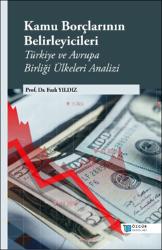| dc.description.abstract | This study aims to empirically reveal the economic, financial, and social factors that determine public debt for Turkey and 27 member countries of the European Union (EU). In this study, conducted in line with these expectations, the panel data analysis method was used to determine the direction and degree of the relationship between economic, financial, and social factors (economic growth, inflation rate, fixed capital investments, current account balance, budget deficit, unemployment rate, interest rate, and corruption) determining public debt for the period 2010-2021 for Turkey and the 27 member states of the European Union (EU). In panel data analysis, PCSE (Panel-Corrected Standard Errors) estimation was made, which is resistant to the problems of model cross-section dependence, heteroscedasticity, and autocorrelation problems in regression analysis, and can correct standard errors according to the panel, which provides more effective and consistent results that allow estimations to be made by eliminating these problems. Additionally, the Granger Pairwise Dumitrescu Hurlin panel causality test method was used to determine the causality relationship between variables.
Panel regression analysis PCSE estimation results show that budget balance, inflation rate, economic growth rate, interest rate, current account balance and fixed capital formation have a negative and statistically significant effect on the amount of public debt; It was determined that the unemployment rate had a positive and statistically significant effect. The effect of the corruption variable on the amount of public debt is positive but not statistically significant. The increase in budget deficits, decrease in inflation, decrease in economic growth, increase in the unemployment rate, decrease in interest rates, decrease in current account deficit, and fixed capital formation have an increasing effect on the size of public debt, according to the research results. Moreover, according to the Granger Pairwise Dumitrescu Hurlin panel causality test results, there is a bidirectional causality relationship between the amount of public debt and the economic growth rate, inflation rate, current account balance, budget balance, unemployment rate, and interest rate; one-way (SSRM ↛ BRC) causality relationship between fixed capital formation and public debt amount; No causality relationship was found between the corruption variable and the amount of public debt.
Based on the result of the research, economic growth-oriented unemployment reduction policies aimed at reducing the size of public debt (public debt stock) in Turkey and EU member states, fiscal discipline-oriented policies aimed at reducing the negative effects of budget equivalence, fiscal discipline-oriented policies aimed at reducing the negative impact of foreign trade policies and current account balance may be recommended to follow policies aimed at eliminating the current account deficit problem. Reducing public debts by implementing policies to reduce the budget deficit and current account deficit in country economies, supporting economic growth by using public resources in more productive areas, will support the development of investment and employment areas and contribute to reducing unemployment. In addition, policymakers need to harmonize borrowing policies, monetary policy, and fiscal policy practices in policies related to interest rates and the fight against inflation in line to ensure economic stability. Since the decrease in the public debt stock will also reduce the debt service (debt principal and interest payments), this situation is expected to positively contribute to the budget balance, current account balance, economic growth, and income distribution in the long term. | en_US |




















